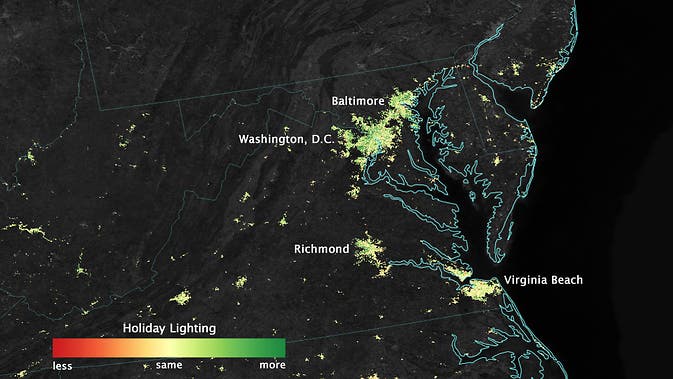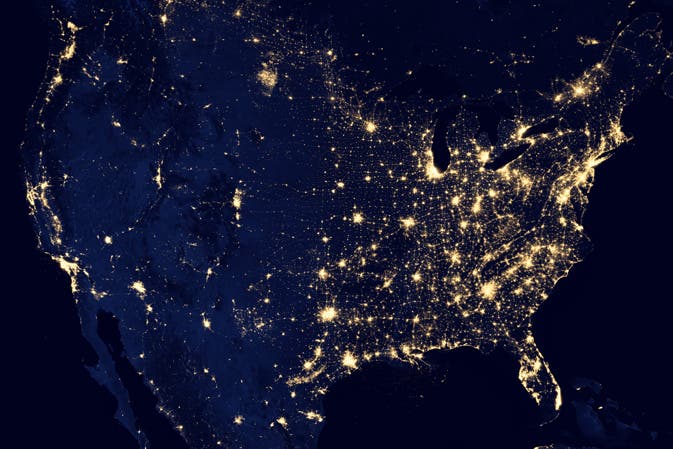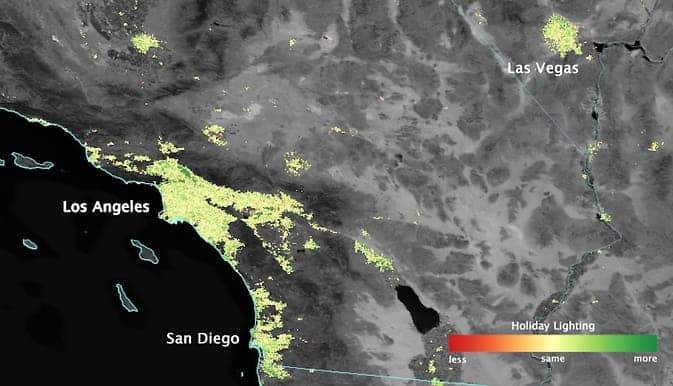Many are already preparing for Christmas – some shopping for presents, some Christmas lights… the usual. But as you’re gearing up for the winter holidays, NASA is watching you. Well, they’re not really watching you, it’s more that they are monitoring light emissions from big cities – and they report that during the holiday season, patterns in nighttime light intensity change – with US nighttime lights shining 20 to 50 percent more.
It’s beginning to look a lot like Christmas

Suomi NPP, a joint NASA/National Oceanic and Atmospheric Administration (NOAA) mission, carries an instrument called the Visible Infrared Imaging Radiometer Suite (VIIRS). VIIRS can observe the dark side of the planet and detect how much the rest (cities) is shining. You’ve probably seen the 2012 “Earth at Night” maps, created from VIIRS data.
This new analysis uses a different algorithm, which filters out the effect caused by moonlight, clouds and airborne particles in order to visualize the lights which come solely from cities. Initial reports already showed more lights were on during Christmas in the US, and in the Middle East during the month of Ramadan.

In the United States, the lights started getting brighter on “Black Friday,” the day after Thanksgiving, and continued through New Year’s Day, said Miguel Román, a research physical scientist at NASA Goddard and member of the Suomi NPP Land Discipline Team, who co-led this research. He and his team are interested in measuring light output in urban areas, as this is one of the major indicators of greenhouse gas emissions.
What they found was that in the American suburbs, light output generally increases by 30-50 percent during the holiday season. In the more central urban areas, even though the growth wasn’t so spectacular, it was still between 20 and 30 percent.
“Overall, we see less light increases in the dense urban centers, compared to the suburbs and small towns where you have more yard space and single-family homes,” said Eleanor Stokes, a NASA Jenkins Graduate Fellow and Ph.D. candidate at Yale University’s School of Forestry and Environmental Studies, New Haven, Connecticut, who co-led the study with Román.
Despite being of different religions and despite having different customs, people want to light up their houses for Christmas.
“It’s a near ubiquitous signal. Despite being ethnically and religiously diverse, we found that the U.S. experiences a holiday increase that is present across most urban communities,” Román said. “These lighting patterns are tracking a national shared tradition.”

Image Credit: NASA’s Earth Observatory/Jesse Allen
Snow and Light
The main limitation of this study is that because snow reflects and alters light so much, they could only analyze cities without snow. So they focused on the West Coast from San Francisco and Los Angeles, and cities south of a rough imaginary line from St. Louis to Washington, D.C.
The idea for this study came after another team analyzed night lights in Cairo in 2012, and they found a huge discrepancy. During the Ramadan, the city simply lit up.
“‘Either you have something going on with your data that’s wrong, or there’s a real signal there that you have to look into,'” Román recalls them saying. When the team investigated the satellite record, they found that the large increase in light output in Egypt’s capital corresponded with the holy month of Ramadan. During Ramadan, Muslims fast during the day, pushing meals and many social gatherings, markets, commerce and more to nighttime hours.

Image Credit: NASA’s Earth Observatory/Jesse Allen
But in order to confirm their findings and rule out an instrumental error, they monitored the city of Cairo for three consecutive years, finding the same results – during the Ramadan, there were significantly more night lights. But not all Muslim cities are the same: while in Saudi Arabian cities, such as Riyadh and Jeddah, light use increased by 60 to 100 percent, in Turkish cities, it increased far less. In cities in Syria and Iraq there was actually no increase at all.
“Even within majority Muslim populations, there are a lot of variations,” Stokes said. “What we’ve seen is that these lighting patterns track cultural variation within the Middle East.”
It would be very interesting to see how these patterns are different in other areas of the world as well – like China, South America and Europe. The way Europeans decorate for Christmas for example may be similar to how Americans do it, but the population and religion distribution is not the same. It would also be very useful to do, because judging by how much more lights are used at night, you could do a raw estimation on how much more greenhouse gas is emitted. This could in turn lead to better decisions regarding energy management and maybe even investments in eco-friendly Christmas decorations.
“Having a daily global dynamic dataset of nighttime lights is a new way for researchers to understand the broad societal forces impacting energy decisions,” Stokes said. And with the Intergovernmental Panel on Climate Change noting that greenhouse gas reductions are going to come from energy efficiency and conservation, scientists and policy makers will need to better understand the driving forces behind energy use.
“More than 70 percent of greenhouse gas emissions come from urban areas,” Román said. “If we’re going to reduce these emissions, then we’ll have to do more than just use energy-efficient cars and appliances. We also need to understand how dominant social phenomena, the changing demographics of urban centers, and socio-cultural settings affect energy-use decisions.”






